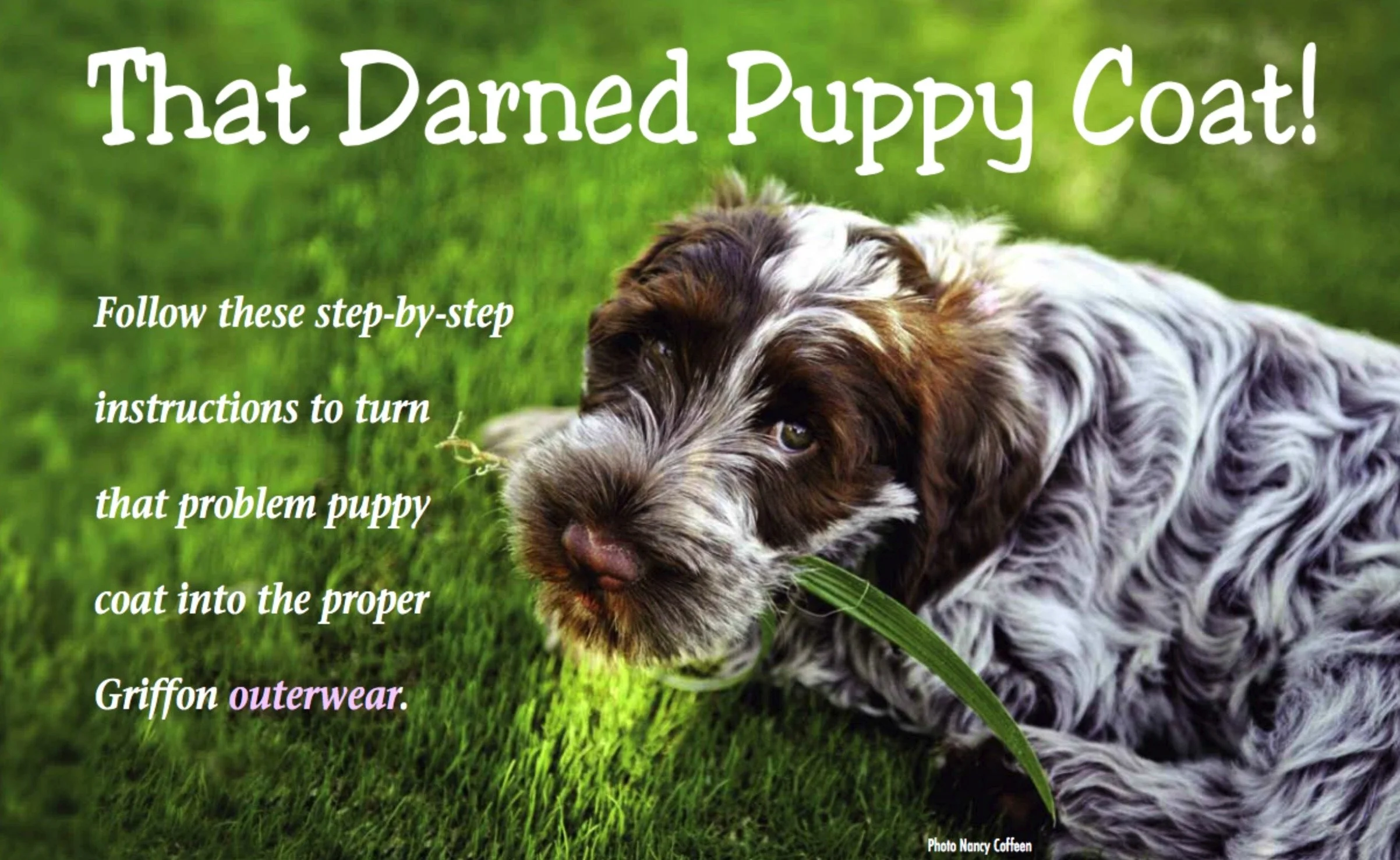The Griffon is first and foremost a serious hunting dog. It is inappropriate to present a Griffon in the breed ring that has been sculpted, stripped, trimmed, back brushed, moussed and sprayed into looking like the proverbial “All-American Show Dog.” That is not to say that a Griffon should not be groomed, nor that exhibitors should present a dog whose coat, body, or feet are not absolutely clean, nor in poor condition. A great Wirehaired Pointing Griffon in excellent physical and mental condition, who is in full coat and is presented well, is a thing of beauty. No artificial enhancement is necessary.
Coat Condition
The coat of a Griffon is an extremely important aspect of this breed and contributes greatly to both functionality and type. A correct wire coat is designed for harsh climates and field conditions, and will not accumulate burrs or other material. To quote the AKC Standard:
“The coat is one of the distinguishing features of the breed. It is a double coat. The outer coat is medium length, straight and wiry, never curly or woolly. The harsh texture provides protection in rough cover. The obligatory undercoat consists of a fine, thick down, which provides insulation as well as water resistance. The undercoat is more or less abundant, depending upon the season, climate, and hormone cycle of the dog.”
A great coat – whether for pets, hunting dogs, or show - is in large part, the result of simple genetics. However, improper nutrition, internal/external parasites, unhealthy environment, poor health, over supplementation, lack of coat care, and/or poor general physical condition of the dog can contribute to the destruction of a perfectly wonderful coat. Unfortunately, it is sometimes possible, although unethical and absolutely against AKC regulations to alter a genetically poor coat (soft, fine, curly, off color, too long, etc.) by using artificial means – however an experienced judge will be able to determine the difference between a naturally correct coat, and an improper one which is being misrepresented.
The difference in grooming techniques between dogs being groomed for the breed ring, versus those who are strictly hunters or pets, is minimal. For instance, pet owners may choose to use clippers for the top of the head, instead of hand stripping. Be advised, though, that using clippers on a wire coat will make the hair that grows back in feel much fuzzier. NEVER shave a Griffon's body coat using clippers.
Authentic Grooming and Coat Care for the Wirehaired Pointing Griffon
The Griffon is first and foremost a serious hunting dog. It is inappropriate to present a Griffon in the breed ring that has been sculpted, stripped, trimmed, back brushed, moussed and sprayed into looking like the proverbial “All-American Show Dog.” That is not to say that a Griffon should not be groomed, nor that exhibitors should present a dog whose coat, body, or feet are not absolutely clean, nor in poor condition. A great Wirehaired Pointing Griffon in excellent physical and mental condition, who is in full coat and is presented well, is a thing of beauty. No artificial enhancement is necessary.
Coat Condition
The coat of a Griffon is an extremely important aspect of this breed and contributes greatly to both functionality and type. A correct wire coat is designed for harsh climates and field conditions, and will not accumulate burrs or other material. To quote the AKC Standard:
“The coat is one of the distinguishing features of the breed. It is a double coat. The outer coat is medium length, straight and wiry, never curly or woolly. The harsh texture provides protection in rough cover. The obligatory undercoat consists of a fine, thick down, which provides insulation as well as water resistance. The undercoat is more or less abundant, depending upon the season, climate, and hormone cycle of the dog.”
A great coat – whether for pets, hunting dogs, or show - is in large part, the result of simple genetics. However, improper nutrition, internal/external parasites, unhealthy environment, poor health, over supplementation, lack of coat care, and/or poor general physical condition of the dog can contribute to the destruction of a perfectly wonderful coat. Unfortunately, it is sometimes possible, although unethical and absolutely against AKC regulations to alter a genetically poor coat (soft, fine, curly, off color, too long, etc.) by using artificial means – however an experienced judge will be able to determine the difference between a naturally correct coat, and an improper one which is being misrepresented.
The difference in grooming techniques between dogs being groomed for the breed ring, versus those who are strictly hunters or pets, is minimal. For instance, pet owners may choose to use clippers for the top of the head, instead of hand stripping. Be advised, though, that using clippers on a wire coat will make the hair that grows back in feel much fuzzier. NEVER shave a Griffon's body coat using clippers.
Grooming Out Your Puppy's Coat
This guide provides insight into managing the unique coat of the Wirehaired Pointing Griffon, especially as it transitions from puppy to adult. Opinions vary on whether the coat should be stripped or left to shed naturally, but for many Griffons, regular grooming is essential. Puppies typically start developing a thicker coat around 4 months old, often requiring consistent grooming to prevent matting, especially around the beard area, which easily gathers debris.
Puppy owners should comb the coat weekly and increase the frequency as the coat thickens. Key tools include a medium/coarse steel comb, Mars Coat King, stripping knife, pumice stone, and mat buster to remove dead hair effectively.
Check out the full article for an in-depth look at specific grooming tools and stripping techniques!



